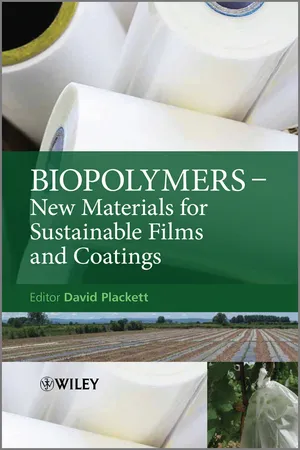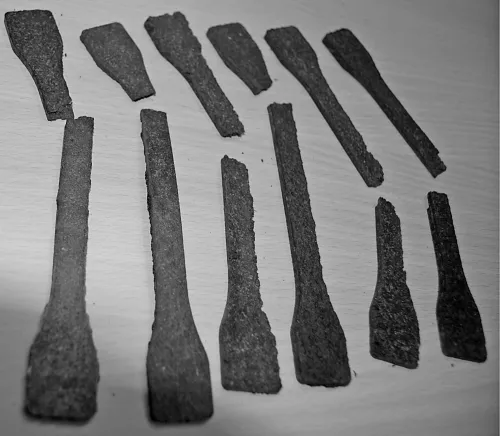![]()
Part I
![]()
Chapter 1
Introductory Overview
David Plackett
Ris
National Laboratory for Sustainable Energy, Technical University of Denmark, Roskilde, Denmark
1.1 Introduction
This book presents the latest knowledge about the synthesis and properties of bio-derived polymers in terms of practical film and coating applications. These biopolymers include starch, polyactides (PLAs), polyhydroxyalkanoates (PHAs), chitosan, proteins, hemicelluloses, cellulose and furan polymers. The contents are divided into two parts: Part 1 in which the synthesis or production and properties of biopolymers are discussed and Part 2 in which specific applications are covered. With this structure, the objective of the book is to provide the reader with an up-to-date summary of current knowledge concerning individual biopolymers and then to discuss the state of their development and uptake in a number of key fields, including packaging, edible films and coatings, paper and paperboard, and agronomy. A further chapter deals with specialized uses of biopolymers in optoelectronics and sensor technologies, a field which is still very much in its infancy. In this introductory overview, biopolymers and the question of sustainability are discussed in the context of total world markets for plastics and resins.
1.2 Worldwide Markets for Films and Coatings
1.2.1 Total Polymer Production and Use
In order to set the scene for this book, it is useful to get a sense of the total volumes and types of polymer used worldwide as well as in use specifically in films and coatings. This includes such everyday materials as kitchen films, grocery carrier bags and garbage bags, and many types of industrial and specialty films, as well as industrial or architectural paints and coatings. Since polymer production and consumption is reported in various ways, it can be difficult to separate out uses in films and coatings from total polymer usage; however, some insights can be gained through reports from industry associations and other sources.
A RAPRA report from 2004 [1] states that in 2003 the total global consumption of polymers in solid form (i.e., not adhesives, paints, binders) was 160 million tonnes and, of this amount, about 40 million tonnes was in the form of films. Information presented by Ambekar et al. [2] illustrates the steady increase in total plastics consumption over the past 50–60 years and indicates that this figure reached 260 million tonnes in 2007, of which about one-third was used in packaging. Volumes of plastics produced worldwide according to figures for 2007 are shown in Figure 1.1. According to the American Chemistry Council (http://www.americanchemistry.com), US production of thermoset resins in 2009 was 12.7 billion pounds on a dry weight basis, down nearly 16% from 2008, probably as a result of the impact of the economic crisis on construction activity. The corresponding figure for thermoplastic production in 2009 was 86 billion pounds which reflected only a 0.5% decrease over 2008, possibly because of the greater diversity of markets for thermoplastics as compared with thermosets.
A report by the consulting company Accenture discusses polymer consumption by market sector in 2006 and consumption figures predicted for 2016 [3]. A summary of the relevant data is shown in Table 1.1.
Table 1.1 World polymer consumption in 2006 and projected consumption for 2016 (thousands of metric tonnes) [3]. Adapted from Accenture report “Trends in manufacturing polymers: Achieving high performance in a multi-polar world”, 2008.
| Construction | 45 886 | 72 919 |
| Plastic products | 43 500 | 78 361 |
| Food | 42 025 | 71 774 |
| Textiles | 32 176 | 51 630 |
| Electrical/electronic | 13 810 | 25 499 |
| Furniture | 13 687 | 22 993 |
| Vehicles and parts | 10 746 | 15 625 |
| Machinery | 2397 | 3658 |
| Fabricated metals | 1519 | 2259 |
| Printing | 780 | 1220 |
| Other transportation | 9330 | 16 181 |
| Other equipment | 3852 | 6334 |
| Other manufacturing | 21 238 | 33569 |
| Total | 240 947 | 402 022 |
1.2.2 Total Production and Use of Plastic Films
The world market for plastic films is dominated by polyethylene (PE) and polypropylene (PP), which together comprise some 34 million tonnes per annum. These polyolefins are subject to increasing demand as the main materials used in packaging films, particularly in the developing areas of the world. Besides PE and PP, polyethylene terephthalate (PET) film is used in packaging and in a wide range of industrial and specialty products, such as in electrical (e.g., transformer insulation films, thermal printing tapes) and imaging products (e.g., microfilm, x-ray films, business graphics). Polyvinyl chloride (PVC) films are found in consumer goods and medical applications and polyvinyl butyrate (PVB), because of its optical clarity, toughness, flexibility and ability to bind to many surfaces, is mainly used in automotive and construction applications as glazing protection. Polystyrene (PS) films are also used in packaging and a variety of other medical, commercial and consumer goods. The primary types of plastics used in films, their properties and various applications are shown in Table 1.2. Polymer films as a whole are a massive market sector with Europe and North America each consuming about 30% of total world production and increasing volumes being consumed in the growing economies.
Table 1.2 Commodity thermoplastic films – their properties and applications (∗ in addition, trays produced by thermoforming films of PET, PE and other thermoplastics are widely used in the packaging industry). PET = polyethylene terephthalate, HDPE = high-density polyethylene, LDPE = low-density polyethylene, PP = polypropylene, PS = polystyrene, PVC = polyvinyl chloride, PVB = polyvinyl butyral.
| PET | Clear and optically smooth surfaces, barrier to oxygen, water and carbon dioxide, heat resistance for hot filling, chemical resistance | Oveneable films and microwave trays, packaging films, industrial and specialty films |
| HDPE | Solvent resistance, higher tensile strength than other PEs | Grocery bags, cereal box liners, wire and cable coverings |
| LDPE | Resistance to acids, bases and vegetable oils, good properties for heat-sealing packaging | Bags for dry cleaning, newspapers, frozen bread, fresh produce and household garbage, shrink wrap and stretch film, coatings for paper milk cartons, and hot and cold beverage cups, wire and cable coverings |
| PP | Excellent optical clarity in BOPP films, low water vapour transmission, inert to acids, bases and most solvents | Packaging, electronics, kitchen laminates, furniture, ceiling and wall panels |
| PS | Excellent water barrier for short shelf-life products, good optical clarity, hard wearing | Packaging, electronic housings, medical products, interior furnishing panels |
| PVC | Biologically and chemically resistant | Packaging films, wire and cable coverings, waterproof clothing, roofing membranes |
| PVB | Adheres well to various surfaces, optically clear, tough and flexible | Laminated safety glass for use in automotive and architectural applications |
Regardless of polymer type, packaging is the main end use for plastic films. In this context, films are generally defined as being planar materials less than 10 mils or ∼250 μm in thickness (i.e., thick enough to be self-supporting but thin enough to be flexed, folded and/or creased without cracking). Above this thickness, the term sheet is frequently used instead of film. Data from Plastics Europe (http://www.plasticseurope.org) confirm that packaging is the biggest end-use for plastics (38%), followed by building and construction (21%), automotive (7%), and electrical and electronic (6%). Other applications for plastics, which include medical and leisure, use 28% of the total production volume (Figure 1.2).
In addition to packaging, the myriad applications of polymer films include decorative wrap, form-fill-seal, blood bags, flexible printed circuits, bed sheeting, diapers, and in-mould decorating of car parts (to replace painting and provide a more durable surface coating) to name just a few. Carrier bags and garbage bags are big markets with significant imports into Europe. In construction, films are used in glazing, damp proofing, tarpaulins, and geomembranes.
Multi-material or mutli-layer films account for around seven million tonnes annually, with about 95% of this volume going into packaging. Multi-layer materials are attractive because they permit custom adaptation of properties such as barrier and strength. As well as the possibility to colour or print, and produce single or multi-layered products, films are also often combined with other materials such as aluminum or paper. An example is the aseptic packaging manufactured by Tetra Pak (Lund, Sweden) which contains layers of PE, paper and a very thin layer of aluminum acting as a water vapour and gas barrier. The introduction of technology such as orientation of PP films has also contributed significantly to the availability of more valuable film materials. In particular,...



